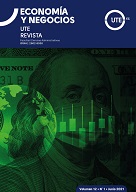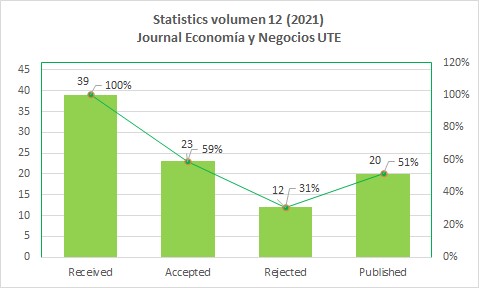Factors Affecting the Variation of FOB Income from Ecuadorian Banana and Plantain Exports
DOI:
https://doi.org/10.29019/eyn.v12i1.902Keywords:
Ecuadorian banana, exports, time series, econometricsAbstract
Exports of raw materials are a fundamental source of income in Latin American countries. Banana and plantain are two of the products that Ecuador exports the most worldwide, which is why the variation in income from these items directly affects the entry of foreign currency into the national economy. The objective of this research is to determine the factors that influence this income variation through analysis and econometric decomposition of the Ecuadorian banana and plantain export time series in the period 2013-2017; as a result of the decomposition, the negative and positive peaks of the irregular component have been obtained and identified; and, these in turn have been categorized according to an analysis of the business environment, with has led to define the key factors that influence the variation in FOB income from the export of Ecuadorian bananas and plantains. The results obtained are relevant since they are an input for the institutions responsible for the generation of public policies to protect and improve the competitiveness of these products in international markets.
Downloads
References
Andrade Rodríguez, P. L., & Meza Lino, A. D. (2017). Trade Agreement between Ecuador and the European Union: The case of the Ecuadorian banana sector [Acuerdo comercial entre Ecuador y la Unión Europea: El caso del sector bananero ecuatoriano]. Revista Espacios, 38(58), 26. Recuperado de: http://ww.revistaespacios.com/a17v38n58/17385826.html
Banco Central del Ecuador. (2021). Evolución de la balanza comercial. Banco Central del Ecuador. Recuperado de: https://contenido.bce.fin.ec/documentos/Estadisticas/SectorExterno/BalanzaPagos/balanzaComercial/ebc202102.pdf
Banco Central del Ecuador. (2020). Estadísticas del sector externo. Recuperado de: https://contenido.bce.fin.ec/home1/estadisticas/bolmensual/IEMensual.jsp
Brassel, F., Breilh, J., & Zapat, A. (2011). ¿Agroindustria y soberanía alimentaria?: hacia una ley de agroindustria y empleo. SIPAE. Recuperado de: http://biblioteca.clacso.edu.ar/Ecuador/sipae/20170627051014/pdf_427.pdf
Camino Mogro, S., Andrade Díaz, V., & Pesántez Villacís, D. (2016). Posicionamiento y eficiencia del banano, cacao y flores del Ecuador en el mercado mundial. Ciencia UNEMI, 9(19), 48–53.
Cleveland, R. (1990). STL: A Seasonal Trend Decomposition Procedure Based on Loess. Journal of Official Statistics, 6(1), 3–73.
De la Cruz Guerrero, L. A., & Rosales Nieto, D. E. (2016). El control aduanero en el Ecuador, una visión al período 2013 - 2016. Economía y Negocios, 7(2), 25–37. https://doi.org/10.29019/eyn.v7i2.171
FAO. (2018). Banana Market Review Preliminary Results for 2018. Recuperado de: http://www.fao.org/fileadmin/templates/est/COMM_MARKETS_MONITORING/Bananas/Documents/Banana_Review_Update_December_2018.pdf
Fierro Ulloa, I. J., & Villacrés Rojas, C. E. (2014). Diagnóstico de la cadena logística de ex- portación del banano ecuatoriano hacia Estados Unidos de América. Saber, ciencia y libertad, 9(1), 77–90. https://doi.org/10.18041/2382-3240/saber.2014v9n1.1985
Gujarati, D. (2007). Econometría. (4ta. ed.). México: Mc-Graw Hill.
Hanke, J., & Wichern, A. (2010). Pronósticos en los negocios. México: Person Educación.
Jiménez Cabrera, J. H. (2018). Teoría de los juegos y su aplicación a los negocios internacionales: acuerdo comercial Unión Europea-Ecuador en el sector agrícola bananero. INNOVA Research Journal, 3(12), 55–66. https://doi.org/10.33890/innova.v3.n12.2018.768
León Serrano, L. A., Arcaya Sisalima, M. F., Barbotó Velásquez, N. A., & Bermeo Pineda, Y.L. (2020). Ecuador: Análisis comparativo de las exportaciones de banano orgánico y convencional e incidencia en la Balanza Comercial, 2018. Revista Científica y Tecnológica UPSE, 7(2), 38–46. https://doi.org/10.26423/rctu.v7i2.521
Lind, D., Marchal, W., & Wathen, S. (2012). Estadística aplicada a los negocios y a la economía (15 ed.). México: McGraw-Hill.
Martínez, H., & Peña, Y. (2005). La cadena del banano en Colombia. Una mirada global de su estructura y dinámica 1991-2005. Ministerio Agricultura y Desarrollo Rural. Observatorio Agrocadenas Colombia (60).
Ministerio de Comercio Exterior. (2018). Informe mensual de comercio exterior - Ecuador.
Moreno Sarmiento, E. (2013). Predicción con series de tiempo y regresión. Panorama, 2(4), 36–58. https://doi.org/10.15765/pnrm.v2i4.262
Murillo, J., Trejos, A., & Carvajal Olaya, P. (2003). Estudio del pronóstico de la demanda de energía eléctrica, utilizando modelos de series de tiempo. Scientia Et Technica, 3(23), 37–42. https://doi.org/10.22517/23447214.73793
Robinson, P. (2010). Responsible Retailing: The Practice of CSR in Banana Plantations in Costa Rica. Journal of Business Ethics, 91(2), 279–289.
Sanderson Bellamy, A. (2012). Banana Produc- tion Systems: Identification of Alternative Systems for More Sustainable Production. Royal Swedish Academy of Science, 42(3), 334–343.
The Observatory of Economic Complexity. (2020). Bananas. Recuperado de: https://oec.world/en/profile/hs/bananas#:~:text=Between%202020%20and%202021%20the,including%20plantains%2C%20fresh%20or%20dried.
Trujillo, D. J., Apunte, R., & Pereira, S. A. (2019). Rui- do en exportaciones de cacao ecuatoriano a mercados internacionales. Espacios, 40, 30. Recuperado de: http://www.revistaespacios.com/a19v40n30/19403003.html
Vásquez Orozco, R. (2010). El impacto del comercio del banano en el desarrollo del Ecuador. Afese temas internacionales, 53(53), 167–182.
Downloads
Published
How to Cite
Issue
Section
Categories
License
Copyright (c) 2021 The Authors

This work is licensed under a Creative Commons Attribution 3.0 Unported License.
The articles and research published by the UTE University are carried out under the Open Access regime in electronic format. By submitting an article to any of the scientific journals of the UTE University, the author or authors accept these conditions.
The UTE applies the Creative Commons Attribution (CC-BY) license to articles in its scientific journals. Under this open access license, as an author you agree that anyone may reuse your article in whole or in part for any purpose, free of charge, including commercial purposes. Anyone can copy, distribute or reuse the content as long as the author and original source are correctly cited. This facilitates freedom of reuse and also ensures that content can be extracted without barriers for research needs.
Creative Commons Attribution 4.0 International License
The Journal Economía y Negocios is distributed under a
Creative Commons Attribution 4.0 International (CC BY 4.0).

In addition, the journal Economía y Negocios guarantees and declares that authors always retain all copyrights to the original published works without restrictions [© The Author(s)]. Acknowledgment (BY): Any exploitation of the work is allowed, including a commercial purpose, as well as the creation of derivative works, the distribution of which is also allowed without any restriction.















